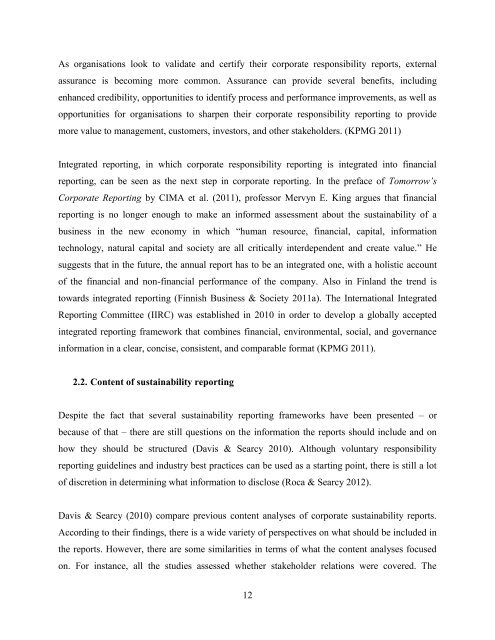Developing sustainability reporting - Case Cargotec - Aaltodoc
Developing sustainability reporting - Case Cargotec - Aaltodoc
Developing sustainability reporting - Case Cargotec - Aaltodoc
You also want an ePaper? Increase the reach of your titles
YUMPU automatically turns print PDFs into web optimized ePapers that Google loves.
As organisations look to validate and certify their corporate responsibility reports, external<br />
assurance is becoming more common. Assurance can provide several benefits, including<br />
enhanced credibility, opportunities to identify process and performance improvements, as well as<br />
opportunities for organisations to sharpen their corporate responsibility <strong>reporting</strong> to provide<br />
more value to management, customers, investors, and other stakeholders. (KPMG 2011)<br />
Integrated <strong>reporting</strong>, in which corporate responsibility <strong>reporting</strong> is integrated into financial<br />
<strong>reporting</strong>, can be seen as the next step in corporate <strong>reporting</strong>. In the preface of Tomorrow’s<br />
Corporate Reporting by CIMA et al. (2011), professor Mervyn E. King argues that financial<br />
<strong>reporting</strong> is no longer enough to make an informed assessment about the <strong>sustainability</strong> of a<br />
business in the new economy in which “human resource, financial, capital, information<br />
technology, natural capital and society are all critically interdependent and create value.” He<br />
suggests that in the future, the annual report has to be an integrated one, with a holistic account<br />
of the financial and non-financial performance of the company. Also in Finland the trend is<br />
towards integrated <strong>reporting</strong> (Finnish Business & Society 2011a). The International Integrated<br />
Reporting Committee (IIRC) was established in 2010 in order to develop a globally accepted<br />
integrated <strong>reporting</strong> framework that combines financial, environmental, social, and governance<br />
information in a clear, concise, consistent, and comparable format (KPMG 2011).<br />
2.2. Content of <strong>sustainability</strong> <strong>reporting</strong><br />
Despite the fact that several <strong>sustainability</strong> <strong>reporting</strong> frameworks have been presented – or<br />
because of that – there are still questions on the information the reports should include and on<br />
how they should be structured (Davis & Searcy 2010). Although voluntary responsibility<br />
<strong>reporting</strong> guidelines and industry best practices can be used as a starting point, there is still a lot<br />
of discretion in determining what information to disclose (Roca & Searcy 2012).<br />
Davis & Searcy (2010) compare previous content analyses of corporate <strong>sustainability</strong> reports.<br />
According to their findings, there is a wide variety of perspectives on what should be included in<br />
the reports. However, there are some similarities in terms of what the content analyses focused<br />
on. For instance, all the studies assessed whether stakeholder relations were covered. The<br />
12
















